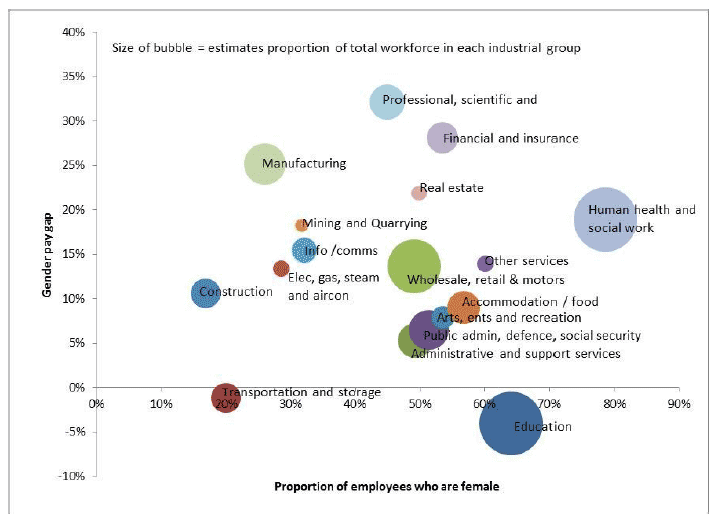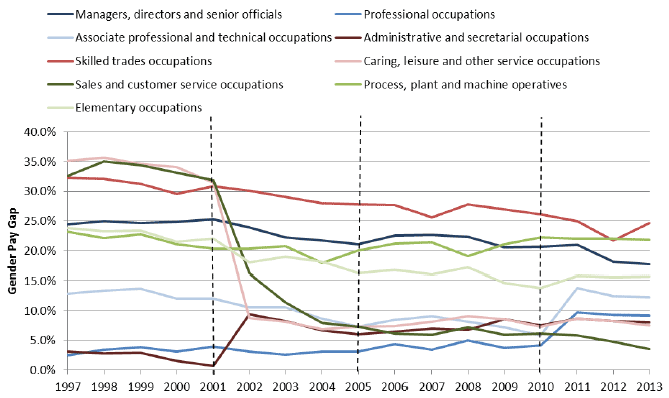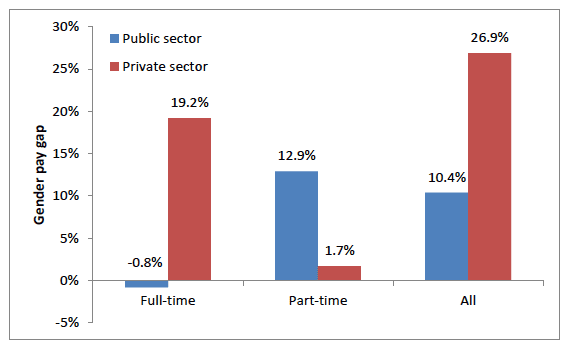New perspectives on the gender pay gap: trends and drivers
This report explains the different measures of the gender pay gap and considers how it has been changing over time. It also considers underlying drivers and describes Scottish Government policy intended to help encourage the decline of the pay gap.
3. The Pay Gap by Industry and Occupation
The headline pay gap figures are also influenced by the proportion of men and women in different occupations. The chart below shows three separate variables which, combined give a sense of the scale and significance of the pay gap in any one sector:
1. The size of the pay gap (vertical axis)
2. The proportion of employees in the sector who are female (horizontal axis)
3. The estimated proportion of total workforce in each industrial group.
It shows that there are particularly high pay gaps in certain sectors such as professional, scientific and technical activities and manufacturing.
There is also a substantial pay gap in human health and social work, combined with a high proportion of employees who are women and a large proportion of total workforce. Manufacturing and wholesale, retail and motors also stand out as having substantial pay gaps in large sectors.
Education stands out as being a large, strongly female sector with a negative pay gap, meaning that on average, women are paid more than men in this sector.
It also shows that there are greater than proportional levels of women in some key low paid sectors, like accommodation and food and other services, many of which are 'elementary occupations' such as waiters and cleaners.
Figure 6: Gender pay gap - median hourly earnings excluding overtime - full-time by standard industry classification 2013-2014, Scotland

Source: Scottish Government analysis using the Annual Survey of
Hours and Earnings data
Notes:
1. Covers employees aged 16+ on the pay as you earn (
PAYE) system on adult
rates and whose pay was not affected by absence.
2. The following sectors had unreliable data and are not
included: Agriculture, forest and Fishing and Water supply:
sewerage, waste management and remediation activities.
Analysis of the pay gap over time by occupation is available at the UK level and is presented in Figure 7. This shows that:
- The highest earning occupations are 'Managers, Directors and Senior Officials' & 'Professional occupations'. For Managers, Directors and Senior Officials, there has consistently been a large pay gap, whilst Professional Occupations (such as scientists, and legal, health and teaching professions) have a lower than national average pay gap.
- Skilled trades (28.9%), process and plant operatives (19.7%) and elementary occupations (16.7%) also have very high pay gaps. Along with managers, directors and senior officials, these gaps have also reduced less than in other occupations.
- Large reductions in the full-time pay gap were seen in sales and customer service occupations, caring leisure and other service occupations.
Figure 7: Gender pay gap for full-time employees by occupational group ( SOC2010) (gross hourly earnings excluding overtime), UK 1997-2013

Source:
UK Department for Culture
Media and Sport (2014) Secondary Analysis of the Gender Pay Gap -
changes in the gender pay gap over time.
Note: Dotted lines represent discontinuities in the data
which make periods not perfectly comparable
The chart below compares public / private sector level data and shows that there is no overall full-time pay gap in the public sector in Scotland, although there is a substantial pay gap for part-time (12.9%) and all (10.4%) employees.
The full-time pay gap is largely driven by the private sector pay gap of 19.2%. The private sector part-time pay gap is only 1.7%, but when full-time and part-time workers are combined again, the pay gap is much larger at 26.9%.
Whilst it can appear odd that the pay gaps differ so much, it is worth remembering that the average hourly wage for part-time work is lower than full-time work, and most people that work part-time are women. When combined again with full-time workers this increases the pay gap considerably.
Figure 8: Gender pay gap by public/private, Scotland, 2015

Source: Annual Survey of Hours and Earnings.
Contact
There is a problem
Thanks for your feedback